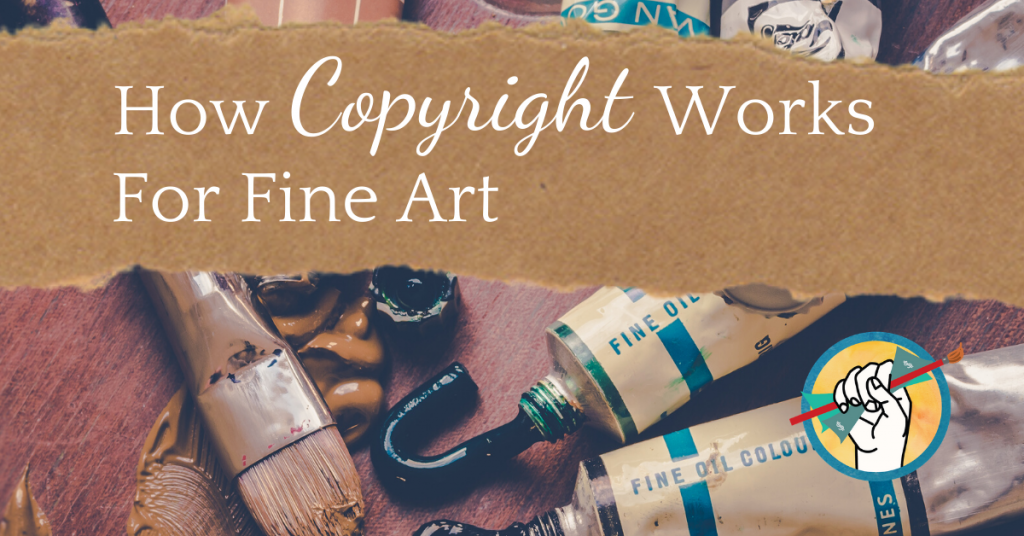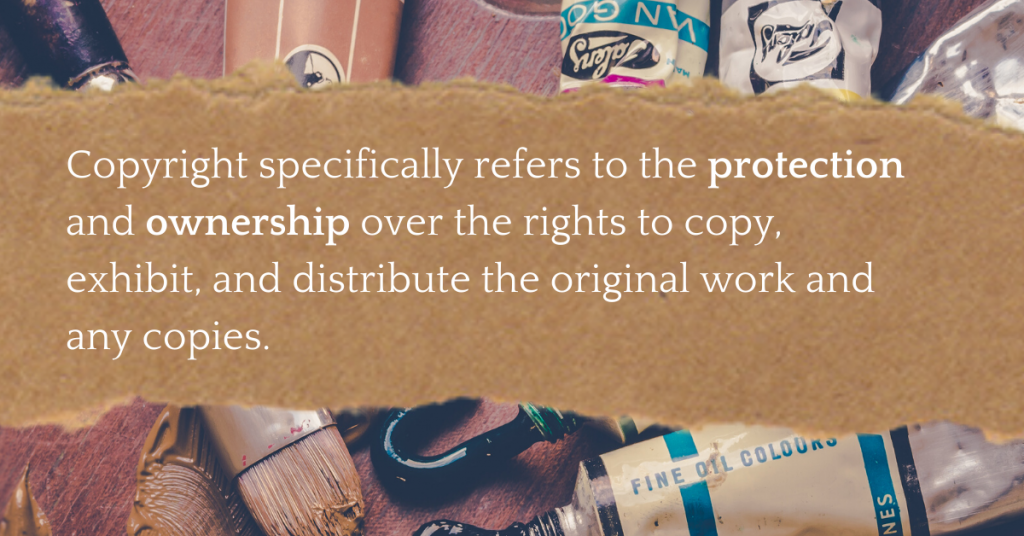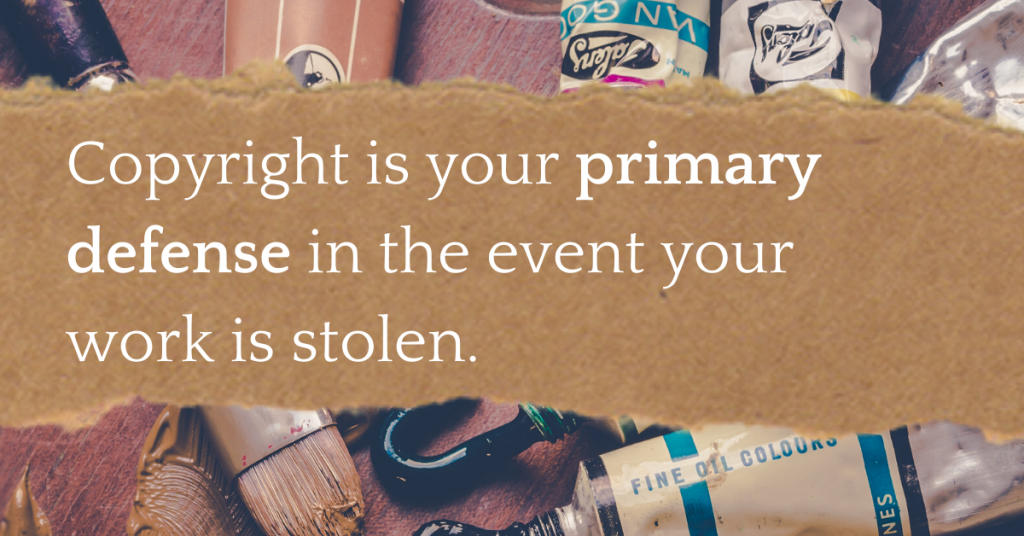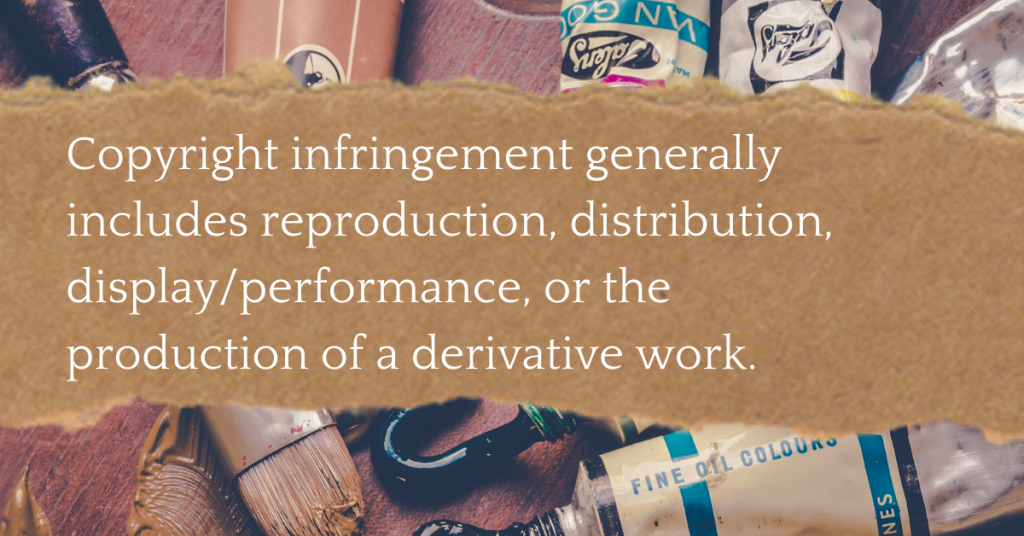When you create a piece of art, what exactly is it that you own? What about the techniques you invented to create it? Do you own those? What happens when you sell the original- what rights to the work do you retain? These are just a couple of the burning (and extremely important) questions that artists have about copyright. While we aren’t legal professionals, we’ve worked hard to lay out the basics of copyright law as it pertains to visual artists in a simple way that makes sense. (This post does not claim to be legal advice, nor should it take its place. Please see resources at the end for some links to law professionals who can help you with specific legal situations.)

What is copyright?
The word copyright refers to the law that protects the work of individuals, including but not limited to literature, music, film, and visual art. The official umbrella term for protected works is “official works of authorship”, according to Title 17 “in any tangible medium of expression, now known or later developed, from which they can be perceived, reproduced, or otherwise communicated, either directly or with the aid of a machine or device. Works of authorship include the following categories:
(1) literary works;
(2) musical works, including any accompanying words;
(3) dramatic works, including any accompanying music;
(4) pantomimes and choreographic works;
(5) pictorial, graphic, and sculptural works;
(6) motion pictures and other audiovisual works;
(7) sound recordings; and
(8) architectural works.”
For the purposes of this post, we are referring to (5) pictorial, graphic, and sculptural work (i.e. visual art).
Copyright specifically refers to the protection and ownership over the rights to copy, exhibit, and distribute the original work and any copies. The simplest way to explain what is and isn’t protected by Title 17 is to walk through an example scenario:
Imagine you create a watercolor painting of a sheep in a field. You start out with a digital color study in Photoshop. You complete the color study in one hour, and you hit “save”. That color study, though it’s not your finished watercolor painting, is immediately protected under copyright law. If you were to upload the image to an Instagram story to share your art-making process, you would not need to include any verbiage to indicate that it is copyrighted- it is protected simply by virtue of being created by you. (However, it is within your legal rights to place a copyright notice on your work- see the proper way to do it here: https://www.copyright.gov/title17/92chap4.html)

Each subsequent draft you may create is also protected by copyright, as well as the final piece. This copyright protection affords you the following:
- Exclusive rights to create and distribute copies of the work both physically and electronically. “Distribution” includes selling, any other transfer of ownership, rental, lease, or lending. Being the copyright owner also gives you the legal right to grant the permission to create and distribute copies to someone else.
- Exclusive rights to prepare derivative works based upon the copyrighted work.
Copyright also means you get to claim authorship of your work, and prevent your name from being associated with any work that you did not create, or any modification or distortion of your work that you do not want associated with your name.
Why do artists need to care about copyright?
Copyright is your primary defense in the event your work is stolen, so it’s important to understand exactly how it applies to your art and what it protects against. There can be no accusation of “infringement” without copyright law, so it can be a powerful ally for artists. The very public case of Lisa Congdon is an example of a copyright infringement dispute that gained a lot of traction in the art world. Read more about the case here: https://lillarogers.com/lisa-congdon-my-art-was-stolen-for-profit-and-how-you-can-help/
Without the legal right to make a copy (this includes derivative works outside of fair use), copyright infringement is illegal, though “it does not generally fall under the same criminal provisions as other types of theft, like stealing someone’s physical property” (LegalZoom).
Copyright is important to understand inasmuch as it is important for you to understand any of your rights as an American citizen- ignorance of the protections afforded to you by the law may lead to you allowing yourself to be taken advantage of simply because you don’t know that there is any other option.

Copyright FAQ
Q: Can I copyright the technique I have developed for my art?
A: No. Even if you believe you are the first artist to ever use this technique, you cannot copyright an art style or technique. You can only copyright the works you create with the technique.
Q: Does selling an original work also sell the copyright?
A: No. Ownership of a copyright and any of the exclusive rights accompanying it is separate from ownership of any material object in which the work is embodied. While it is possible to transfer a copyright, the copyright for any work does not automatically transfer along with the sale of the original work. (Clients who desire some of the exclusive rights of a copyright owner should be expected to pay extra: see our post on Exclusivity in Artist Contracts.)
Q: What qualifies as a derivative work?
A: A derivative work is a work based on an existing copyrighted work. Common examples of derivative works include translations, musical arrangements, and art reproductions. As it relates to visual art, a derivative work would be something like a sculpture based on a drawing, a painting based on a photograph, or a drawing based on a painting. A derivative work is sometimes called an adaptation. Adaptations may only be produced with permission from the original copyright owner. For more information on derivative works, check out this download from the U.S. Copyright Office: Circular 14: Copyright in Derivative Works and Compilations.
How do I register my copyright with the copyright office? (And do I need to?)
First of all, registration is not a condition of copyright protection. Your work is protected as soon as you create it. Registration does, however, carry with it the perk of definitive proof of the date of the copyright and definitive proof that you are the owner of the copyright. This is helpful if you ever need to pursue legal action for copyright infringement. Also of note, the available damages are more significant if you have registered your work with the copyright office. Some artists, authors, and musicians choose to register their copyright before publishing their work.
In order to register your copyright with the U.S. Copyright Office, you must send in a copy of the work (called a deposit) in addition to filling out the application and paying a fee of $35+ (depending on the variables of the work in question). To see the fee breakdown, download this PDF: Copyright Office Fees. Check out this free checklist from Kiffany Stahle: Ready to Register Your Copyright?
What do I do if my copyright is infringed?
It’s every artist’s nightmare. You are perusing a Christmas ornament catalog when suddenly you see a set of ornaments decorated in the exact style of a recent original painting series you created and published online. It can’t be a coincidence… can it? Before you can pursue legal remedy, you need to be certain that your copyright was indeed infringed, and that the case does not fall under fair use.
According to Title 17, the definition of infringement is as follows:
Anyone who violates any of the exclusive rights of the copyright owner as provided by sections 106 through 122 or of the author as provided in section 106A(a), or who imports copies or phonorecords into the United States in violation of section 602, is an infringer of the copyright or right of the author, as the case may be.
Again, the referenced “exclusive rights” as they apply to visual arts are:
(1) to reproduce the copyrighted work in copies
(2) to prepare derivative works based upon the copyrighted work;
(3) to distribute copies of the copyrighted work to the public by sale or other transfer of ownership, or by rental, lease, or lending;
Copyright infringement generally includes reproduction, distribution, display/performance, or the production of a derivative work.
So what do you do?
According to Title 17, all civil and criminal proceedings must be enacted within 3 (for civil cases) or 5 (for criminal cases) years of the original date that the infringement was made. This makes it very important to pay attention to where your art is appearing- there is a statute of limitations on copyright infringement cases.
When you discover what you suspect is copyright infringement, some finesse may be required. Where did the copyrighted work appear? Is it being sold for profit? Is there any chance that the work is merely very similar to yours, but not a copy? Ask yourself these questions once you’ve calmed down enough to see straight, and consider whether you should approach the individual directly or whether you should hire a lawyer. A lawyer may be the better option for dealing with large companies or cases where it’s very clear that the other party is profiting off of a clear copy of your work.

One of our favorite resources for dealing with infringement issues is Kiffanie Stahle of The Artist’s J.D. She has put together a huge list of free and paid legal resources for artists. Check out her free workbook on How to Deal With Copycats. If you are a member of The Abundant Artist Association, you can also access a replay and transcript of our exclusive interview with Kiffanie: Copyright Basics with Kiffanie Stahle.
Fair Use
There are cases when an individual is protected by Fair Use, a doctrine in copyright law that allows for your work to be used without penalty in certain cases including commentary and criticism (including teaching) and parody. For example, under fair use a teacher may take an image of your work and include it in a slide show about the history of watercolor painting, or an art critic may reproduce it in an article critiquing work that you showed publicly. If you feel that your copyright has been infringed upon, a judge will consider four factors:
(1) whether the work was used for commercial or non-profit purposes
(2) the nature of the original copyrighted work
(3) the amount of the work used
(4) any effect the use may have on the market value of the copyrighted work
Final Thoughts
Because copyright law is the artist’s primary line of defense against intellectual theft, it’s imperative that artists understand how it works, what it protects, and what it doesn’t. That being said, there are some artists who have educated themselves on copyright law and have decided to shirk the model in favor of a much more open and interactive way of engaging with their fans, admirers, fellow artists, and customer base. Gwenn Seemel has some unorthodox ideas about copyright that have worked very well for her art business. She disseminates her work freely without restrictions on personal or commercial use. As she says in her post A Business Model for an Artist Who Does Not Use Copyright, “though this business model involves a lot of hard work, it’s a whole lot easier than the other route, the one that embraces copyright. In going that way, an artist is gambling. The driving force in that career path is the fervent hope that one day the artist will make a work that everyone wants a piece of, a work that they can cash in big on with the help of licensing fees and copyright infringement lawsuits.”
Gwenn’s views on copyright and how art is best shared is encouraging even if you disagree with her ideas, because she proves that artists whose desire is not to be boxed in by convention are limited only by the confines of their imagination, and perhaps their willingness to step outside their comfort zone.
Have you had a good or bad experience with US Copyright Law? Do you agree with Gwenn’s point of view, or have you relied on copyright to keep your business afloat? Let us know in the comments!
Further reading
Copyright Law of the United States (Title 17)
Copyright Basics (Artists Rights Society)
A Beginner’s Guide to Copyright Law for Artists (CartoonBrew)
Gwenn Seemel, Art Marketing, Copyright, and More (The Abundant Artist)
How YouTube Sees Copyright (The Abundant Artist)
Copyright Basics with Kiffanie Stahle (The Abundant Artist Association members only)
1. Your link to the Lila Congdon case is not the original.
The original was removed – quite possibly because of some of the comments on it relating to other matters relating to alleged abuse of copyright BY Lisa Congdon.
2. You also didn’t look at OTHER links about Lisa Congdon and copyright.
Try reading this one http://theartedge.faso.com/blog/66723/lisa-congdon-vs-cody-foster-what-about-the-photographers
Copyright infringement does not only apply to art, it can also be about photography. Photographers enjoy exactly the same protection as artists and the reason that THIS POST is still up and in the public domain should tell you something…..
The 583 responses also have quite a lot to say about copyright in relation to art and some are well worth reading.
A lot of people learned a lot about copyright back in 2013 from reading that post.